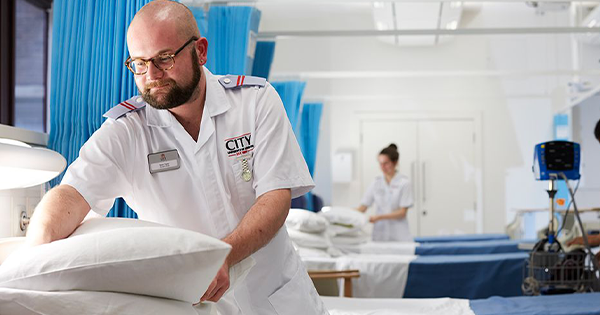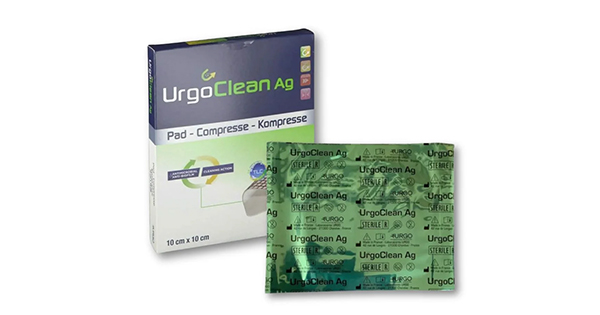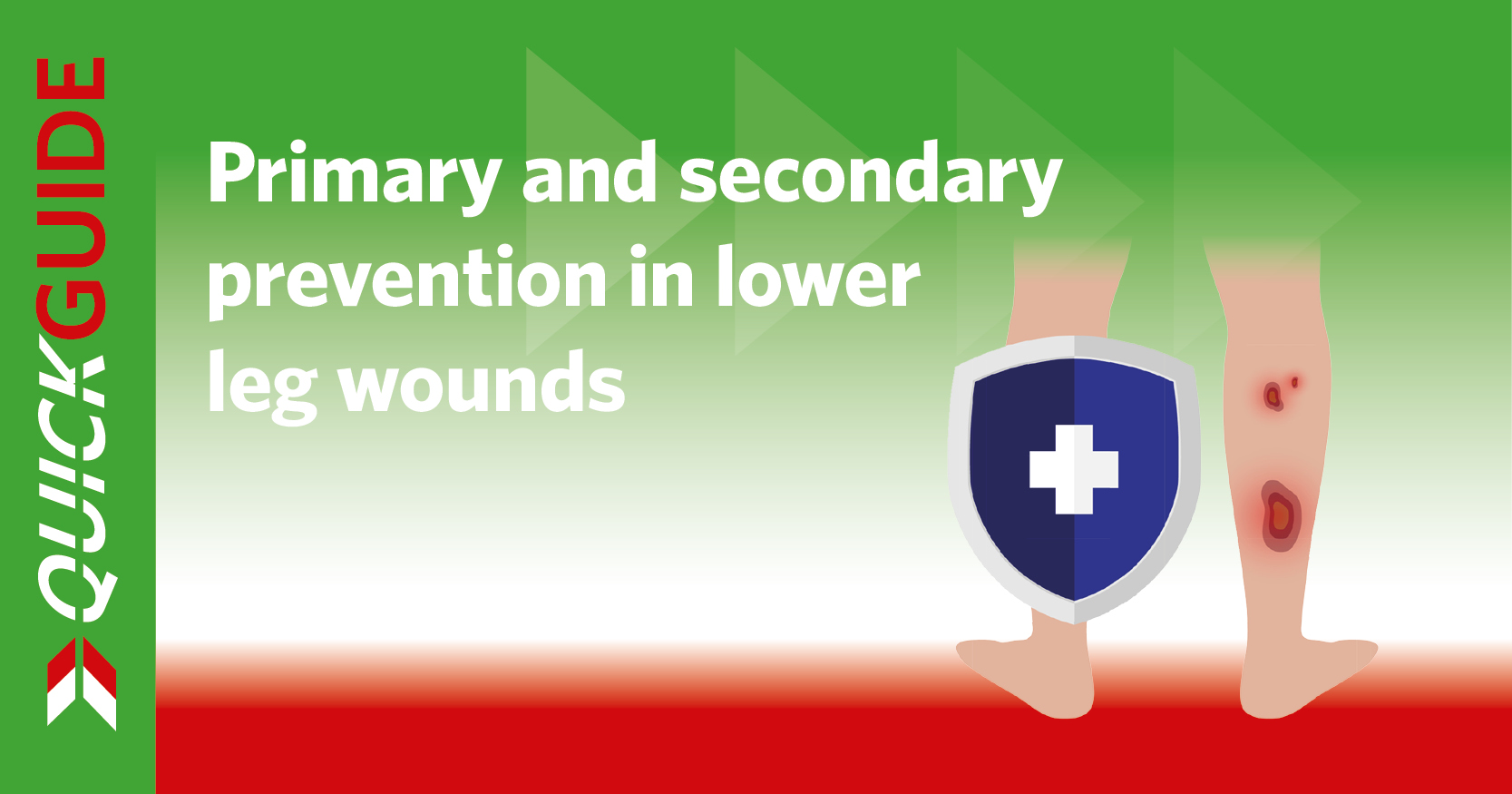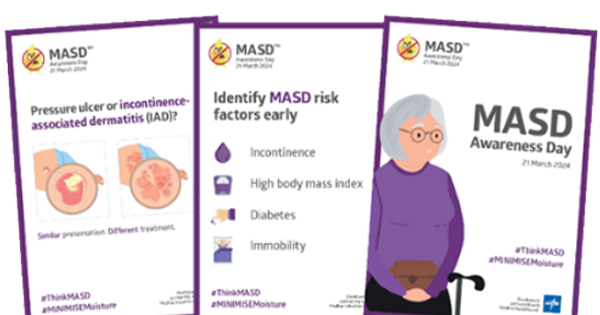Selecting the most appropriate surface (i.e. provides the best pressure redistribution) is complex as many factors have to be considered, particularly when determining which surfaces to use in a whole organisation, such as a hospital or care home. The equipment needs to meet the varying needs of a diverse population, as well as contribute to:
- Maintaining or improving patient independence
- Good infection prevention protocols
- Supporting good moving and handling practices
- Meeting patient safety requirements
- Conforming to sustainability and net zero targets
- Being financially sound.
Most organisations will offer a range of surfaces to meet the different levels of patient risk, as well as different patient sizes from children to adults and underweight to plus-size, with differing weight redistributions often related to their clinical conditions – e.g. gross lower limb oedema or bilateral amputation. Equipment should also be appropriate to the patient’s risk level and specific risk factors, with patients at higher risk or with existing pressure ulcers requiring more sophisticated protection from external mechanical forces.
Meeting this myriad of requirements is challenging and in order to understand differences between products, measures such as interface pressure (IP) are used to provide comparisons. However, IP is not without limitations, and any comparison must be viewed critically, with a full understanding of what the readings mean and what the implications are for clinical practice.
Measures of IP (which is pressure at the interface between the body and the support surface; Box 1) have been frequently reported as surrogate indicators of support surface pressure redistribution efficacy. However, the relevance of IP measurement on individuals is questionable, given the wide inter-individual responses to applied loads, uncertainty of the relationship between surface pressure and potentially damaging stress and strain in deeper tissues (European Pressure Ulcer Advisory Panel, [EPUAP], et al 2019).
IP measurements are often used to describe the benefits of a particular surface (e.g. mattress or cushion) or discriminate between different surfaces (de Labachelerie et al, 2022), modalities (Clark et al, 2022) or positions (Marfil-Gomez et al, 2020). They have been used to assist in the selection of specific wheelchair cushions for several years (Chen and Ping, 2022). Recently, as IP measurement has become more user-friendly, it has helped to select bed-based support surfaces for individuals in their own home. IP measurements are also used to demonstrate to staff and patients the importance of correct usage of particular surfaces or positions to help reduce the patient’s risk of developing pressure ulcers (Hultin et al 2017; Caggiari et al, 2020; NHS Cornwall Partnership, 2021).
The measurement seeks to demonstrate a relationship between the applied load (i.e. the body weight), the ability of the surface (e.g. mattress or cushion) to distribute that load and the impact the surface has on microcirculation. However, this is a complex process, and the load required to occlude the vessels is unknown and varies considerably between individuals. It can also vary between body site, state of health (e.g. changes in blood pressure or circulating blood volume) and body shape/weight distribution.
The majority of work on IP measurement cites the seminal work of Landis (1930), which used an invasive technique to examine the pressure needed to occlude the capillary bed, at the base of the finger-nail bed, of healthy human subjects. The most commonly quoted average pressure required to occlude arterioles in the limb is 32mmHg. However, average pressures of 20mmHg (range: 18–32mmHg) at the end of the arteriolar limb and 12mmHg (range: 6–18mmHg) in the venous limb were also identified. The author clearly stated that these figures are not generalisable as they are subject to variation by a range of factors, including elevation of the limb due to hydrostatic pressure, as well as changes in temperature and the individual’s general health.
While 32mmHg is often cited as the pressure threshold above which ischaemia and resulting pressure ulceration will occur, it is not a universal discriminator for harm. Some individuals or body sites are able to tolerate higher pressures and others struggle to tolerate 32mmHg. It is evident that less pressure is required to occlude the vessels directly over a bony prominence where the load is concentrated between two non-yielding surfaces, than over areas where tissues – such as subcutaneous fat and muscle – distribute the load over a greater surface area. While there is some guidance on the measurement of IP (Tissue Viability Society, 2010; Sylvia et al, 2020), these do not include thresholds to represent specific levels of performance as it will vary from person to person (EPUAP et al, 2019).
IP measurements on their own should be used with caution when discriminating between products. While pressure is a key component in the development of pressure ulcers, it is now widely acknowledged that shear and tissue deformation also play a very significant role in tissue damage, and these cannot be measured using IP (Linder-Ganz and Gefen, 2007). Support surface characteristics such as immersion, envelopment and microclimate play a key role in the ability of products to prevent or delay the onset of pressure ulcers and these are not measured by IP, although they may have an impact on the measurement of IP.
The majority of studies to evaluate pressure redistributing equipment which use IP are performed on volunteers over a short time period with a short ‘settling in’ time. Volunteers are typically healthy individuals; therefore, their morphology and tissue tone, particularly musculature, may not represent that of many patients. Hospitalisation is known to significantly affect patients, particularly the elderly, resulting in significant deconditioning and loss of muscle mass, muscle strength and functioning, resulting in an inability to hold the body in a ‘healthy posture’ (Kamper et al, 2020). The pressure map produced on the healthy individual may, therefore, differ considerably from that of a frail elderly patient. A similar effect is seen in patients with decreased levels of alertness, such as those in intensive care units or those taking night sedation (Pepperl et al, 2014).
It is not always clear in research studies if bed linen is used between the volunteer and the surface, as this can also impact on mattress performance. This is particularly the case in mattresses where the surface allows the patient to sink in, giving great conformity and, therefore, better pressure redistribution. A stiff hospital sheet can reduce this ability to conform, and this is exacerbated when multiple layers are placed between the patient and the support surface; for example, incontinence pads or moving and handling equipment.
When reviewing an IP study data, certain key factors should be considered including:
- The size of the sensor array — i.e. how big is the pressure mapping mat and how many sensors does it have?
- The number and type of subjects used, for example human, mannequin or indentor
- The amount of rest or ‘settling in’ time; and the time over which measurements were recorded for
- The patient position(s) used when IP was recorded
- If any additional material, such as bed linen, was placed between the subject and the surface
- The type of surface used, for example active or reactive
- The room temperature and humidity
- Presentation of study findings.
Alongside these factors, it is important to bear in mind that testing conditions and pressure mapping systems vary, which can cause challenges when comparing IP studies. For example, some pressure mapping systems only range from 1 to 100mmHg while other systems include measurements of up to 200mmHg. Additionally, a pressure of 100mmHg will look blue (low pressure) on a system that measures 1 to 200mmHg; however, the same area will appear red (high pressure) on a system that measures 1 to 100mmHg.
Size of sensor array
In order to capture the total body distribution of pressure, a full-size sensor pressure mapping mat should be used when evaluating mattresses and a seating size one should be used for cushions or chairs.
Number and type of subjects used
Where human volunteers are used, they should represent a range of body types in both height and weight. Gender and age should also be reported. The use of human subjects precludes comparison between studies as subject variance cannot be controlled. Where artificial alternatives are used, their size, shape and composition should be fully described.
Rest and recording times
Allowing time for the subject to rest prior to taking recordings allows the body to take on a more natural position and mould into the surface in a more naturalistic way. If the surface is active, measurements should be taken over more than one cycle to ensure all phases are captured in the data.
The patient position
The position of the subject when the IP is recorded should reflect how patients would typically lie in bed. Very few patients lie completely flat, so measuring IP in this way represents an artificial load distribution. Placing the patient in a semi recumbent position with a maximum of 30-degree head-of-bed elevation more realistically replicates clinical practice. However, this position is much harder to replicate as the individual is far more likely to slide down the bed (depending on bed design), causing shear and possible distortion of the sensors away from the bony prominences.
Layers between the subject and the surface
Provision of bed linen and different types of clothing can affect both the distribution of load and local microclimate, which affects both the sensor reading and tissue deformation.
The type of surface
The way the mattress works can affect the readings from the sensors; however, unless it is sufficiently flexible to follow a deflated cell, it will hammock at that point and give an artificially high reading.
Room temperature and humidity
Both room temperature and humidity can also affect sensor accuracy and tissue deformation.
Presentation of study findings
Findings from research studies need to be closely analysed to be sure of constancy in comparing like with like. Studies typically present their findings in a variety of ways to show:
Interface pressure: The pressure load between the skin and the support surface (measured in mmHg)
Peak interface pressure: The highest-pressure load between the skin and the support surface (measured in mmHg)
Average interface pressure: The average pressure load between the skin and support surface of a full body or the specific area calculated by the pressure mapping device (measured in mmHg)
Skin contact surface area: The total contact area between the skin and the support surface (measured in square inches), and the pressure redistribution to a small, concentrated area and over a larger surface area (Teleten et al, 2022)
Each of these measures presents something different but interrelated about the mattresses reviewed and, therefore, need to be considered individually, but also together to give a whole picture of performance.
Given the complex and interrelated nature of the many variables associated with an individual’s response to applied pressure, it seems naive to assume that measurement of IP can be used to select and rank support surfaces for a whole hospital population. While IP profiles may be considered in the selection process, they must be taken in context of other multiple measures as, without this, they are often very misleading.
However, more recently, IP has been used to great advantage in both increasing clinician knowledge and practice (Hultin et al, 2017; 2019; Ho et al, 2023), patient concordance with mattress choice and repositioning (NHS Cornwall, 2021) and demonstrating how even small position changes can redistribute pressure (Yun et al, 2023). This is perhaps where this type of measure has the most utility, showing what works best for a specific individual or demonstrating to a clinician the efficacy of a specific intervention.
The PROMISE project (pressure reduction through continuous monitoring in the community setting; NHS Cornwall, 2021) uses mattress and chair sensors in patients’ homes, which continuously measure and record the patient’s body surface pressures. The IP sensors are linked to a computer which displays the IPs in real-time and visually identifies the areas of the body under sustained pressure. This helps the patient or carer to better understand the positions that are likely to reduce the risk of pressure ulcers, and encourages the patient to reposition where necessary. Use of continuous monitoring has reduced the number of pressure injuries and reduced the number of truly non-concordant patients and medical device-related pressure injuries.
Hultin et al (2017) demonstrated how using IP to show clinicians where high spots of pressure were after repositioning resulted in adjustments to the position that patients were placed in. This led to lower peak pressures and more preventative actions occurring. In a follow-up study with patients themselves, Hultin et al (2019) worked with 31 orthopaedic patients to find a new way of understanding which helped them to recognise vulnerable pressure points and to take action in their own care.
Although the number of studies using IP with individual patients is small and quite labour intensive, research shows promise with specific groups of patients in supporting adherence to suggested equipment and repositioning regimens; facilitating supported self-care; increasing patient autonomy; and improving clinician knowledge and skills.
Conclusion
The use of interface pressure either as single peak readings or pressure maps is not a reliable way to help select equipment for whole organisations or specific departments. Reliance on these readings for the purpose of tendering should be urgently reviewed, and more subtle and clinically relevant measures which consider the range of mechanical forces, and the real-world application of the surfaces, should be used.







